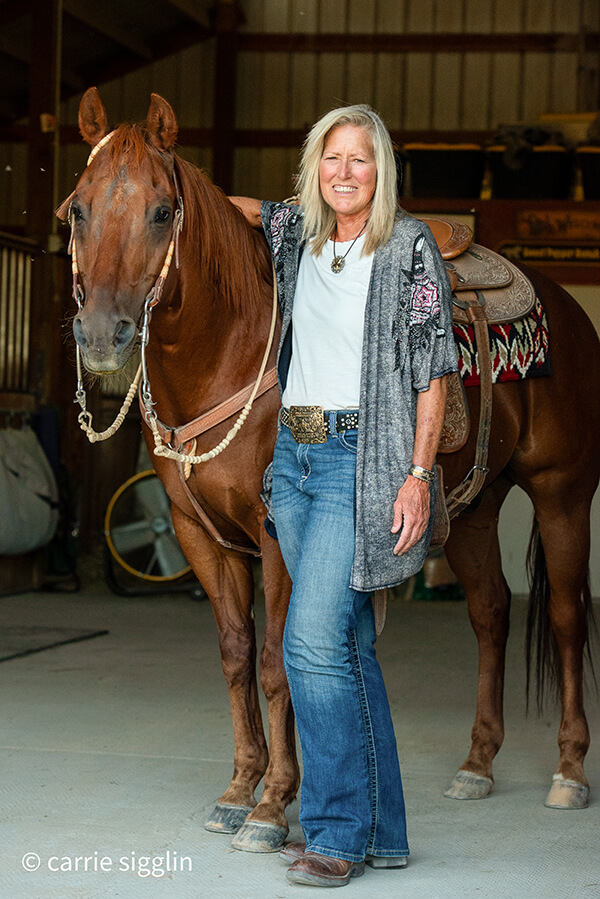Rubber stall mats are the gold standard in horse stall flooring. Unfortunately, they’re so cumbersome in size and shape, they can be a struggle to place perfectly in a stall. If not perfect, they end up working themselves loose, twisting, turning and creating hassles.
Anita Medina and her two horses live in Hobart, Washington. She and her horses have lived in three different neat and tidy locations, all of which Medina designed from the ground up. In each location, horses have had access to both unbedded stalls and individual, outdoor paddocks. “My horses never poop or pee in the matted stalls because it splashes on them.” Instead, Medina’s horses defecate outdoors in their gravel pens.
“I like plain [smooth] stall mats [without bedding] because there’s no mess and they are easy to sweep up. I don’t want to spend more time then needed doing chores,” she says emphatically. “I sweep daily because my horses like to lie down in their stalls. If I don’t [sweep], the gravel [from the paddocks] tracks in and when the horses lie down, they get hock sores.”
Medina also likes the clean stall mats because if her horses pull hay out of their corner feeders, they end up eating on a clean floor without risk of ingesting sand or dirt. “My compost bin composts way faster because it’s just straight manure,” without a lot of carbon bedding material, says Medina.
For installation, Medina has the stall mats placed on top of four to five inches of level, compacted 3/8 inch minus crushed rock (angular rock with the fine materials which will compact). Medina gets mats to fit tightly together by carefully trimming them to fit snugly upon installation. “I also run a sander lightly across all seams, so edges aren’t rough, and the exposed edges are lessened.” Additionally, this lessens the chance of her horses developing hock sores.
Long term maintenance? Medina has had stall mats in horse stalls for up to 10 years without replacing them. “In the summer I just hose down the stalls and mats (once) and it freshens things up plus gets rid of dust and cobwebs.”
Step-By-Step: How to Properly Install Stall Mats
Gather the following supplies and equipment:
- For stalls with bare (dirt or clay) floors you will need enough gravel (crushed rock, size 3/8” to 5/8”) to fill the stall area up to about 1” below the desired level. Do not use pea gravel or sand as it won’t compact. (For cement floors, skip this step and begin at step #6 below).
- Stall mats (enough to cover the entire stall)
- Two vice grips (four is even better) or stall mat grippers (tools designed specifically for handling stall mats)
- Carpet knife (also called a utility knife)
- Straight edge at least 3’ long
- Tape measure
- Chalk (or chalk line) to mark the mats for cutting
- Hand compactor (you can rent or borrow this)
- Carpenter’s level
- Rigid metal garden rake
- Two 2×4 boards — one should be treated and long enough to install across the front of the stall door, the other should be 6 to 8 feet long.
Install the mats:
- Attach the treated 2×4 across inside of the stall doorway (Note: Skip this step if your stall already has a lip or an edge at least 2 ½” high. For cement floors start with step #6 below.)
- Add 5/8” minus gravel gradually (spreading as you go) up to the top of the 2×4.
- Use the garden rake to smooth and do a rough leveling of the gravel in the stall.
- Use the eight-foot 2×4 and level to level the gravel in the entire stall.
- Compact gravel with hand compactor. The compacted gravel should be about 1” below the desired finish line.
- Use a long pry bar or metal T-post to carry the mats to the stall area – two people can carry the bar with the mat draped across it.
Note: This next step is a critical part of the process. Minimize the number of cuts made and avoid using small pieces of leftover mat (less than two inches wide) to fill in gaps.
- Position all the mats that do not require cutting. Using vice grips or mat grippers as handles, maneuver the mats into position. Determine how you want to cut the remaining mat(s).
- Measure the space remaining and mark the mats with chalk. Fit stall mats snuggly together, leaving about 1/8” to 1/4” space between mats.
- Use the straight edge and the utility knife to cut the mats (make multiple slices to cut all the way through the mat).
And you’re done! The horses (and you!) are now ready to enjoy your smooth, flat stall flooring.
Check out the Horses for Clean Water website for the latest on upcoming events including workshops, online classes, and tip sheets. For info on our spectacular 3½ day Sweet Pepper Ranch Cowgirl Retreats which include ranch riding, yoga, meditation, lectures, demos, gourmet meals, field trips, and relaxing pool time, visit sweetpepperranch.com

Alayne Blickle began in the 1990’s as a pioneer in water conservation and natural resources conservation by creating the entrepreneurial consulting business, Horses for Clean Water, an award-winning internationally acclaimed education program that looks for horse-healthy, nature-based solutions to land management challenges. She continues this work today partnering with agencies, organizations, and horse owners throughout North America and worldwide. She is a regularly contributing writer and photojournalist to several equine publications.
Alayne lives with her horse trainer husband, Matt Livengood, in southwestern Idaho where they raise and train AQHA horses and mustangs on their eco-friendly horse ranch. Contact her through the Horses for Clean Water website or through their ranch website Sweet Pepper Ranch.
For more information contact Alayne at [email protected] or 206-909-0225.






